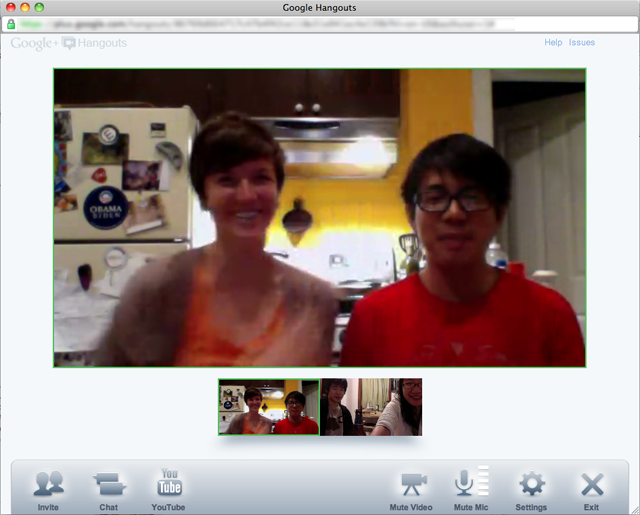Google+ Hangouts Prototype, Take 2!
In my meeting with our Thesis Dev teacher Frank Chimero this week, he advised 2 things:
- Aim to run 2 prototypes a week (iterate faster!)
- Experiment with different social groupings (# of people, relationship to host, etc.)
With #1 in mind, I ran another Google+ Hangouts prototype on Wednesday. With #2 in mind, I invited just one person: a friend on the west coast.
Two unexpected things happened after the Hangout started. First, my friend’s significant other arrived on the scene, and secondthe recipe I chose turned out to require a lot of diced onions. The onions are relevant, because my significant other (Yang) is a champion-grade onion chopper (whereas it tends to be an exercise in pain management for me) so he, too, joined us. What started off as a meetup between two old friends turned into a couples cook-off.
First, it entirely changed the social dynamic. Having some strangers in the mix meant there was a lot of mutual curiosity. We asked each other about jobs, interests, what-the-hell-my-thesis-is, and all sorts of other things. Cooking took tons longer than expected as a result. But we had a great time getting to know each other.
Second, and this is the great part, the mutual curiosity turned into an actual dinner together. We ended up finishing the dish at the same time and decided, why not, let’s just stay on Google+. We set our laptop on our table, and they on theirs, and we ate the same dish (albeit cooked 2 different ways) while connected via video chat.
Unlike while cooking, we were able to spend time looking at one another’s video streams, literally spending face-to-face time together. We had real conversations, without the distraction of simultaneously monitoring a bubbling pot. We clinked beer bottles/wine glasses via our screens, giggled hilariously, and even fork-jousted (no fear of exchanging germs here). It felt a lot like dining with friends in real life, except with a 2500-mile and 3-hour gap in space and time. But by the end of the meal that was hardly noticeable; we were all very happy and full. Prototype #2 turned into an experience that was surprisingly very, very good.
After last week’s prototype, one of my testers sent me the following feedback:
…I would also seriously enjoy to do this with my friends back in Norway on the weekends – so that I could make a hearty lunch while they prepare their dinner (6 hours time difference)
This observation makes so much sense now. I hadn’t thought too much about this before, but food really does have amazing connective properties—not just across cultures, but across space and time as well. After all, this was a friend I hadn’t seriously spent time with in years, and I had just visited his home, gotten to know his significant other, lectured him on knife position (it was seriously worrying), and shared a great meal with him. The time difference can be an issue, as my tester pointed out above, but all that melts away when everyone is affixed at their table with a nice plate of delicious food.
I have a clearer picture in my mind now of what I need to do to recreate this great experience for others:
- make it ridiculously easy to set and confirm a cooking date (across time differences)
- then create an interface that puts food front-and-center when you’re creating it…
- …and melts away into just you and your friend(s) when you’re done cooking and eating together
